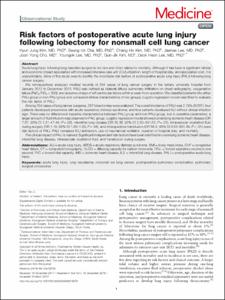KUMEL Repository
1. Journal Papers (연구논문)
1. School of Medicine (의과대학)
Dept. of Internal Medicine (내과학)
Risk factors of postoperative acute lung injury following lobectomy for nonsmall cell lung cancer
- Keimyung Author(s)
- Kim, Hyun Jung
- Department
- Dept. of Internal Medicine (내과학)
- Journal Title
- Medicine
- Issued Date
- 2019
- Volume
- 98
- Issue
- 13
- Keyword
- acute lung injury; lung neoplasms; nonsmall cell lung cancer; postoperative pulmonary complication; pulmonary surgical procedures
- Abstract
- Acute lung injury following lung resection surgery is not rare and often related to mortality. Although it has been a significant clinical and economic impact associated with increased intensive care unit (ICU) utilization, length of hospital stay, and associated cost, it is unpredictable. Aims of this study were to identify the modifiable risk factors of postoperative acute lung injury (PALI) following lung cancer surgery. We retrospectively analyzed medical records of 354 cases of lung cancer surgery in the tertiary university hospital from January 2012 to December 2015. PALI was defined as bilateral diffuse pulmonary infiltration on chest radiography, oxygenation failure (PaO2/FiO2<300), and absence of sign of left ventricular failure within a week from operation. We classified patients into either PALI group or non-PALI group and compared clinical characteristics of two groups. Logistic regression model was fitted to evaluate the risk factor of PALI. Among 354 cases of lung cancer surgeries, 287 lobectomies were analyzed. The overall incidence of PALI was 2.79% (8/287); four patients developed pneumonia with acute respiratory distress syndrome, and four patients developed ALI without clinical infection sign. There was no difference in baseline characteristics between PALI group and non-PALI group, but in operative parameters, a larger amount of fluid infusion was observed in PALI group. Logistic regression model showed underlying ischemic heart disease (OR 7.67, 95% CI 1.21–47.44, P=.03), interstitial lung disease (OR 30.36, 95% CI 2.30–401.52, P=.01), intravascular crystalloid fluid during surgery (OR 1.10, 95% CI 1.00–1.20, P=.04), and intraoperative transfusion (OR 56.4, 95% CI 3.53–901.39, P<.01) were risk factors of PALI. PALI increases ICU admission, use of mechanical ventilator, duration of hospital stay, and mortality. The clinical impact of PALI is marked. Significant independent risk factors have been identified in underlying ischemic heart disease, interstitial lung disease, intravascular crystalloid fluid, and transfusion during surgery.
- Keimyung Author(s)(Kor)
- 김현정
- Publisher
- School of Medicine (의과대학)
- Citation
- Hyun Jung Kim et al. (2019). Risk factors of postoperative acute lung injury following lobectomy for nonsmall cell lung cancer. Medicine, 98(13). doi: 10.1097/MD.0000000000015078
- Type
- Article
- ISSN
- 1536-5964
- Source
- https://insights.ovid.com/pubmed?pmid=30921242
- Appears in Collections:
- 1. School of Medicine (의과대학) > Dept. of Internal Medicine (내과학)
- 파일 목록
-
-
Download
 oak-2019-0097.pdf
기타 데이터 / 231.67 kB / Adobe PDF
oak-2019-0097.pdf
기타 데이터 / 231.67 kB / Adobe PDF
-
Items in Repository are protected by copyright, with all rights reserved, unless otherwise indicated.